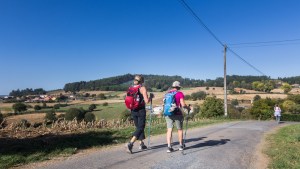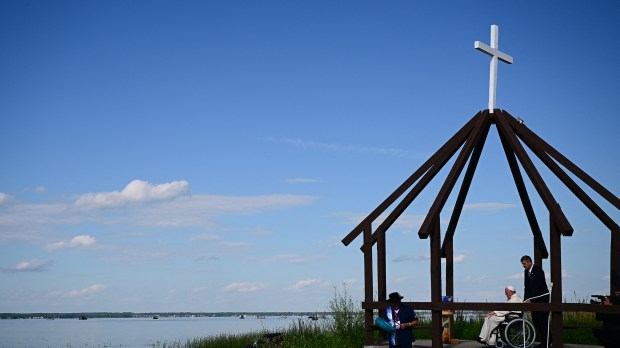In Alberta, on the third day of his trip to Canada, Pope Francis visited a place sacred to Canadian natives and dedicated to Jesus’ own grandmother: Lake St. Anne, whose waters he blessed by turning to the four cardinal points during a gathering on July 26, 2022, the feast day of the shrine’s namesake.
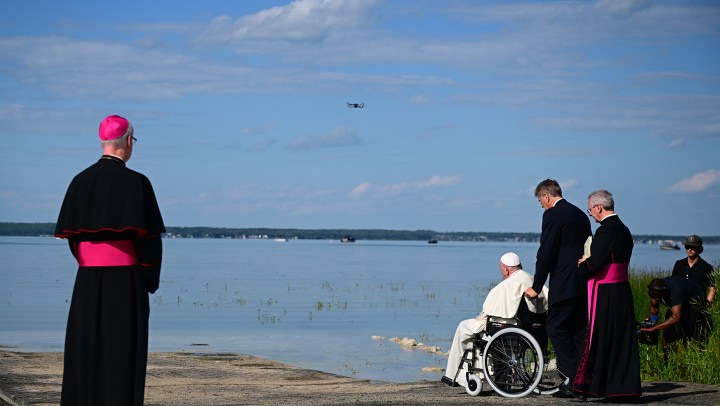
The lake is located some 80 kilometers from Edmonton, and since the 19th century has attracted 40,000 people each year for a major pilgrimage.
Once called “Lake of God” (Wakamne) or “Lake of the Spirit” (Manito Sahkahigan), it is considered a sacred place and, as at Lourdes and other sanctuaries, the waters are considered healing.
The Sioux of the Alexis Nakota Nation settled on its shores long before European settlers, led by a chief who, according to the legend, received a vision of this lake where the trees would whisper their traditional song.
When a Catholic mission was opened there by the Oblates of Mary Immaculate in 1844, the lake was named after St, Anne. The first pilgrimage was organized in 1889, inspired by the shrine of St. Anne of Auray in Brittany, France.
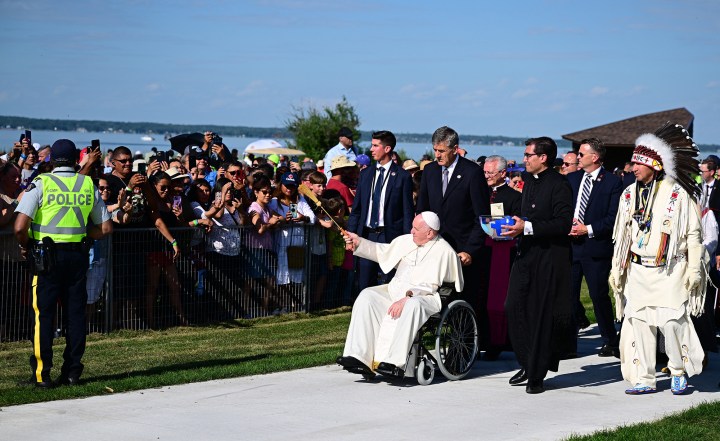
Attracting many Indigenous peoples — Cree, Dene, Blackfoot, Métis — this pilgrimage is an opportunity for communities to express their special devotion to the grandmother of Jesus – the grandmother being an important figure in their culture. “St. Anne is the patron saint of Quebec, and we can say that she is the patron saint of all Indigenous people in Canada,” said Father Erik Oland, provincial of the Jesuits in Canada, who came to Alberta to follow the events with the pope.
The pontiff in his wheelchair made a slow advance, to the rhythm of drums, to a pier of the lake. There, overlooking the glistening waves in the late afternoon light, he blessed the lake as bishops accompanying the annual pilgrimage have done for decades, with these words: “Bless all those who will enter this water and use it. Protect them in their daily journey to you and in their service to others and to the care of creation.”
At the end of the celebration, he offered the pilgrims a handcrafted sculpture of “Mary Undoer of Knots,” created by Canadian sculptor Timothy Schmalz.
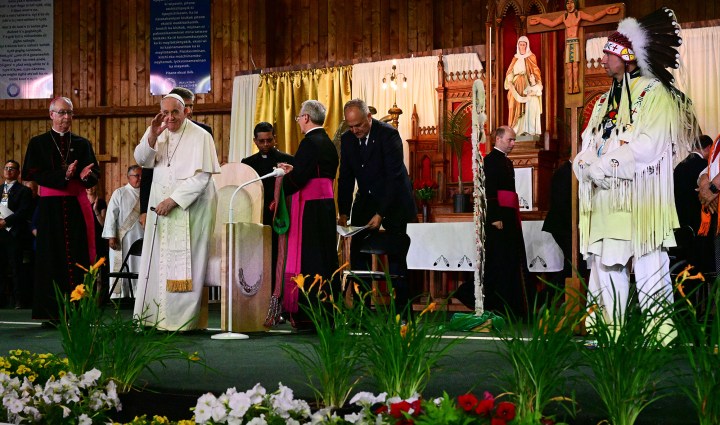
Pope Francis defended the vital role of mothers and grandmothers in this process of handing on the faith, citing his own grandmother but also Our Lady of Guadalupe, patroness of the Americas from the Canadian Arctic to the Pontiff’s Argentina.
Yes, Lord, we entrust ourselves to the intercession of your mother and your grandmother, because mothers and grandmothers help to heal the wounds of our hearts. At the dramatic time of the conquest, Our Lady of Guadalupe transmitted the true faith to the indigenous people, speaking their own language and clothed in their own garments, without violence or imposition. Shortly afterwards, with the arrival of printing, the first grammar books and catechisms were produced in indigenous languages. How much good was done in this regard by those missionaries who, as authentic evangelizers, preserved indigenous languages and cultures in many parts of the world!
In Canada, this “maternal inculturation” took place through Saint Anne, combining the beauty of indigenous traditions and faith, and fashioning them with the wisdom of a grandmother, who is a mother twice over. The Church too is a woman, a mother. In fact, there has never been a time in her history when the faith was not passed on in mother tongues, passed on by mothers and grandmothers. Yet, part of the painful legacy we are now confronting stems from the fact that indigenous grandmothers were prevented from passing on the faith in their own language and culture. That loss was certainly tragic, but your presence here is a testimony of resilience and a fresh start, of pilgrimage towards healing, of a heart open to God who heals the life of communities.
All of us, as Church, now need healing: healing from the temptation of closing in on ourselves, of defending the institution rather than seeking the truth, of preferring worldly power to serving the Gospel.
Dear brothers and sisters, with God’s help, let us help one another in offering our own contribution to the building up of a Mother Church pleasing to him: capable of embracing each of her sons and daughters; a Church that is open to all and speaks to everyone; a Church that is against no one, and encounters everyone.
Lake St. Anne, recognized by the Canadian government as a National Historic Site since 2004, has been the site of an annual pilgrimage during the week of July 26 since 1889.
Considered a place of healing by local people for centuries, this lake called “Lake of God” by the Nakota Sioux or “Lake of the Spirit” by the Cree people took the name of Jesus’ grandmother at the initiative of missionary Jean-Baptiste Thibault, who created a permanent Catholic mission there in 1842.
